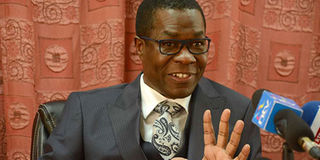MPs to query use of Sh150bn insurance cover

Public Accounts Committee chairman Opiyo Wandayi addresses the media at Parliament on October 24, 2018. He said they will look into the use of money allocated for the self-insurance fund for public servants. PHOTO | FILE | NATION MEDIA GROUP
What you need to know:
- The formula for allocating premiums is 2.25 per cent of the annual wage roll of all public servants.
- Treasury CAS Gaichuhie said the government was planning to use the kitty to enhance the NHIF cover once the systems are in place.
The ghost of Sh150 billion allocated by the National Treasury as insurance cover for public servants reeks of a scandal.
Whereas the government has been allocating Sh15 billion annually to the self-insurance fund under Group Personal Accident (GPA) policy and Work Injury Benefit Act for public servants for the past 10 years, those entitled to benefits from the scheme are yet to get a penny in compensation.
This begs the question: How has the fund been utilised and who are the beneficiaries, if any?
The formula for allocating premiums, according to the National Treasury’s operating policy framework of 2009, is 2.25 per cent of the annual wage roll of all public servants.
According to the Economic Survey paper of 2018, the average annual wage earnings of public servants is Sh694.981 billion.
The insurance cover was rolled out through the May 2006 Human Resources Policies and Procedures manual for public service policy designed to cover permanent bodily injury or death arising from accidents.
VALID CLAIMS
Public servants, within the definition of the manual, include those in civil service, National Police Service, Judiciary, Kenya Defence Forces, county governments, public universities, parliamentary service, State corporations and all statutory bodies.
The manual defined the nature of claims as those related to accidents while riding on motorcycles, including pillion passengers, accident out of exposure to banditry and similar risks in the course of duty, government drivers deployed to drive privately registered donor partner vehicles.
It therefore means all public servants who have died or have been injured in the line of duty since 2009 have valid claims.
“Any claim is required to be reported by the insured, dependants or nominee in writing and submitted within a year of the injury or death,” the manual reads.
Interestingly, to date, many public servants have never been compensated through the GPA and Wiba, neither have they been sensitised to report claims, an issue that has drawn the attention of the National Assembly.
NHIF
Ugunja MP Opiyo Wandayi, who chairs the Public Accounts Committee (PAC), said the committee would dig into the matter to unravel the truth.
“Definitely, this is an issue that catches the attention of any watchdog entity, be it EACC or DCI. We shall be liaising with the Office of Auditor General to have a special audit done,” Mr Wandayi said.
Treasury Chief Administrative Secretary Nelson Gaichuhie admitted the existence of the GPA and Wiba annual budgetary allocations.
He said the government was planning to use the kitty to enhance the NHIF cover once the systems are in place.
“This is going to be the first time the money will be going to NHIF so that victims can file claims and get compensated,” he told the Nation.
He however did not explain why the allocation has not been benefiting victims and why public servants have not been sensitised about it.





